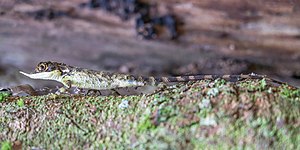Horned dragon
| Horned dragon | ||||||||||||
|---|---|---|---|---|---|---|---|---|---|---|---|---|

|
||||||||||||
| Systematics | ||||||||||||
|
||||||||||||
| Scientific name | ||||||||||||
| Ceratophora stoddartii | ||||||||||||
| Gray , 1834 |
The rhino-horned lizard ( Ceratophora stoddartii ), also spiked nose Agama called one within the family of Agamas (Agamidae) to the genus of Hornagamen ( Ceratophora ). It was first described in 1834 by the British zoologist John Edward Gray .
features
The horned dragon reaches a head-torso length of about 8 cm and a total length of up to 23 cm. The body is slim. The head, which is greenish-brown to black on the top and on the sides, is relatively short and sloping concave towards the muzzle. The shields of the upper lip and the throat and neck are colored white. The eye is at least partially outlined in light brown or yellowish. The white, narrow and round horn on the tip of the snout is characteristic; it is made of soft tissue and gave the group of horned dragons its name. Females have a shorter horn, in 42% of the females it is completely absent, occasionally also in males. The horned dragon has an erect fold of skin on the neck. The mostly dorsal dorsal scales are irregularly arranged and overlap like a brick, the scales of the flanks are larger, sometimes with a white border. The basic color of the trunk and tail is olive green, females are generally grayer. The back is marked by 5 to 6 dark transverse spots and narrow, black longitudinal stripes, each of which is only formed from a row of scales. The long tail is marked by dark transverse bands that widen towards the tip of the tail.
Way of life
The horned dragon is tree-dwelling, it lives mainly on tree trunks. She shows no pronounced escape behavior and relies on her camouflage . In general, the species is quite sluggish and comparatively slow. It feeds on all kinds of small arthropods , such as crickets and small crickets . The mating takes place peacefully, the female is not held by the male with a neck bite. The horned dragon reproduces through oviparia (laying eggs). The clutch usually consists of 4 eggs that are buried in the forest floor. Horned dragons form territories that are defended. The neck fold is set up to impress.
distribution
The range of the horned dragon is in the mountains of Sri Lanka , where it is endemic . It occurs at altitudes between 1500 and 2100 meters. The habitat is light forest areas, the lizard can also be found in gardens. The horned dragon is rare and one of the endangered species.
literature
- Günther Nietzke: The terrarium animals. Construction, technical equipment and planting of the terrariums. Keeping, feeding and caring for terrarium animals. Volume 2: turtles, bridge lizards and lizards. Plants in the terrarium, fundamental questions and problems relating to the biology and ecology of reptiles, outdoor terrariums. 4th, revised and redesigned edition. Ulmer, Stuttgart 1998, ISBN 3-8001-7179-1 .
Individual evidence
- ↑ Ceratophora stoddartii in The Reptile Database ; Retrieved January 6, 2011.
- ↑ Conservation - Reptiles of Sri Lanka ( Memento of the original from October 4, 2014 in the Internet Archive ) Info: The archive link was inserted automatically and has not yet been checked. Please check the original and archive link according to the instructions and then remove this notice.
